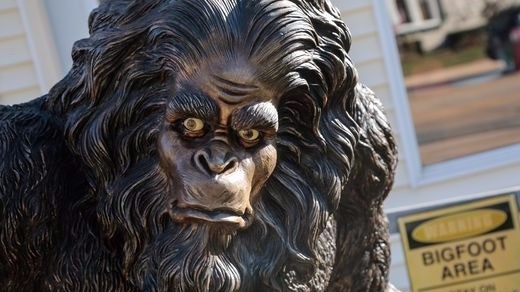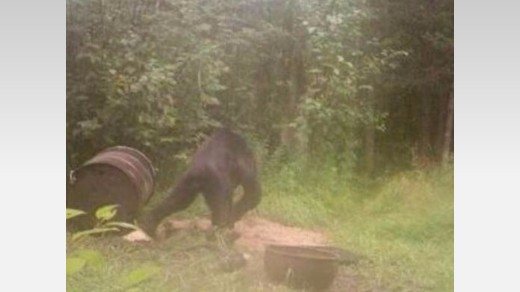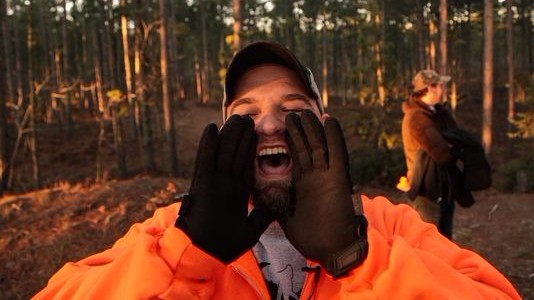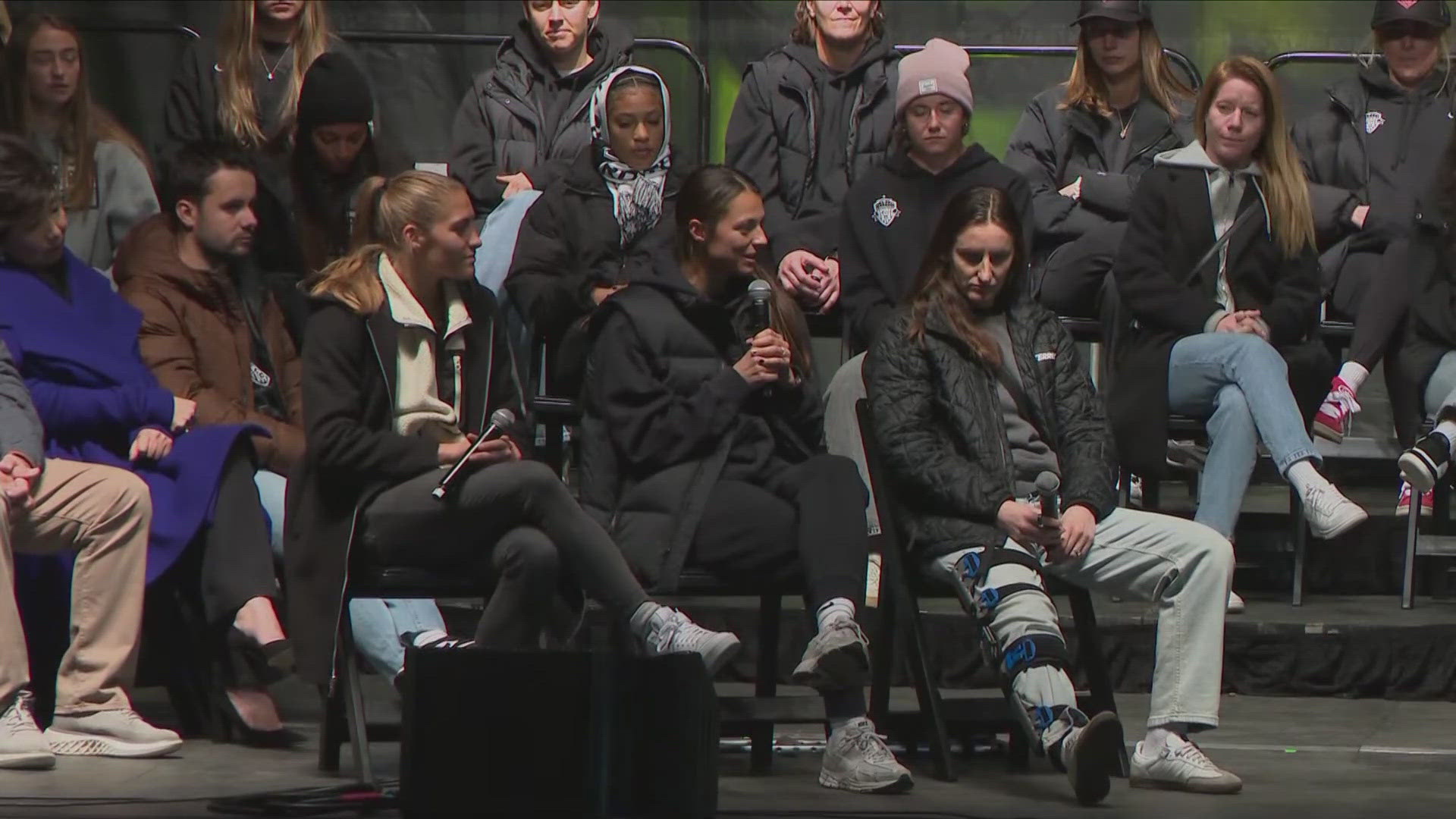Maybe Bigfoot did this. Maybe.
Rich Meyer stood in an Upper Peninsula forest, calling his friend over to a spot along a trail. He’d found something.
A tall, thin sapling had been bent into an arch over the path, high above everyone’s heads. Its tip was wedged in the underbrush, holding it down. This, Meyer said, might be a sign. Bigfoots, he explained, often leave signals to each other using sticks or trees. Arches are common.
“It can be a marker of some kind, almost like a road map,” said the 39-year-old.
Meyer is the founder of the Upper Peninsula Bigfoot/Sasquatch Research Organization, dedicated to finding proof that Bigfoot is real and living in the U.P.
On that fall afternoon, he and Shawn Mullins, a fellow Bigfoot investigator, were scouting the woods at the edge of the Seney National Wildlife Refuge, 95,000 dense acres of unspoiled wilderness in the central Upper Peninsula. If Sasquatch is real, the investigators thought, this would be a great place to hide. And a likely place to find proof that he exists.
“Look at this,” Mullins said, walking over to a spot where about a dozen long sticks leaned upright on one another to form a vague “X” shape. This, too, is said to be common in Bigfoot stick language.
“It’s interesting because of how it’s kind of interweaved like that,” said Mullins. The 36-year-old looked it over carefully. “A lot of these branches were probably laying down right here, and it’s almost like they were deliberately put up and weaved into an ‘X’ like this.”
He wasn’t convinced, though. “Could be something, could be nothing,” he admitted.
It's been a busy year for the group. Bigfoot has been all over the news. First, there was a sighting in May of a possible Bigfoot seen on a camera mounted above an eagle’s nest in a tree in Beulah, near the Platte River State Fish Hatchery in the northern Lower Peninsula. It made news all over the world.

Then there was the photo of a Bigfoot-looking something, taken by a trail cam mounted on a tree in the western Upper Peninsula this fall, as the mystery creature was combing through a campsite.
And the first-ever Upper Peninsula Bigfoot convention in August drew a hundred or so Yoopers to share their own Sasquatch stories, which many had kept to themselves for years.
“In the U.P., we’re all pretty tight-lipped up here. We don’t like to share a lot anyway,” Meyer said. “And with the stigma that’s been with Bigfoot over the years, you got a lot of older people who think, ‘People are going to call me crazy,’ so they don’t like to share unless they see a bunch of other people sharing.”
It’s not for nothing his group’s motto is “Bigfoot research and counseling without ridicule.”
Mullins and Meyer were in the forest that afternoon because the wildlife refuge is known as a hot spot for Bigfoot encounters. The investigators had been here before, hoping to have a Bigfoot interaction of their own. Later that night, in these woods, they’d get that interaction. Maybe.
“It would be one of the best things that happened to me, other than meeting my wife and having my son,” Meyer said of encountering Bigfoot. “It would validate all the time and effort we’ve all put in.”
Born to be wild
There are legends about a Bigfoot-type wild man in the folklore of just about every culture in the world. In North America, it’s part of the mythology of several Indian tribes, and the name “Sasquatch” is derived from the term for “wild men” used by tribes in the Pacific Northwest.
The myth spread through popular culture after the 1967 appearance of the Patterson-Gimlin film, the most famous Bigfoot evidence so far, which shows a hairy creature on a leisurely stroll through the California woods. Ever since, there's been an explosion in reported sightings all over the country, including in most Michigan counties.
In general, Bigfoot is described as covered in fur, standing 8 feet tall or more, walking upright, making only fleeting appearances in eyewitness accounts, blurry photos and a lot of shaky videos. Some people believe it’s a close relative of humans, something between man and ape with peculiar characteristics, like sometimes leaving woven stick gifts for homeowners near its habitat in exchange for things like marbles. He’s said to communicate by howling or banging sticks on trees. And he reportedly stinks.
Concrete proof, though, has been elusive.
“We don’t have a body yet,” Meyer said, summing up the plight of the Bigfoot believers community in general. “Once there’s a body, or evidence where it shows someone being somewhere and a Bigfoot is right next to them — where it’s irrefutable — then the scientific community will jump on board.”
Until then, modern science generally regards the Bigfoot phenomenon as little more than scams, hoaxes and mistaken identity by overexcited observers — like that Bigfoot supposedly spotted on a trail cam this summer. A frame taken seconds later showed it was just a bear bending over awkwardly. And that Bigfoot seen on the eagle cam this year? The truth turned out to be even more absurd. More on that later.
In general, scientists say there’s no way a giant ape-man could survive this long without a huge breeding population to sustain it. That if Bigfoots were real, one of them should have been killed or captured by now. And they ask why are all the photos and videos of Bigfoot so blurry and inconclusive?
But a few outspoken dissenters point to recent discoveries showing that different species of hominid, like the Neanderthal, have coexisted with humans more recently than previously believed, suggesting Bigfoot’s parallel existence is not so unlikely.
“Some of these branches of this now-bushy family tree have existed alongside us until the recent past,” said professor Jeffrey Meldrum, an anthropologist with Idaho State University and the closest thing to a national Bigfoot expert. “Why not into the present? Why presume they’re all extinct in the face of all the evidence?”
The 58-year-old professor has spent years studying Bigfoot lore, collecting evidence, following up on eyewitness accounts and presenting his findings at conferences. He’s determined to approach Bigfoot using scientific methods, and the lack of scientific validation so far is disappointing.
“Of course it’s frustrating, having to deal with the skeptics and critics in the absence of definitive proof,” he said. “My goal is not to convince people that Bigfoot exists. I would like to demonstrate that Bigfoot exists with that evidence.”
The evidence so far consists of plaster castings of supposed Sasquatch footprints, supposed Sasquatch hair samples that are often traced back to common wildlife, and so-called stick structures in the woods, said to be deliberately created by Bigfoot.
The problem with those, Meldrum admitted, is that, as with much Bigfoot evidence, these stick creations could have been caused by something else — like the weather, or the chance arrangement of fallen timber, or kids just making a fort. When it comes to Bigfoot, the evidence is often just a "maybe," never a "for sure."
“I’ve been out with people for whom every overturned log or upturned tree is immediately attributed to Sasquatch,” Meldrum said. “If you find what you think is a tree structure, you need to have some associative evidence; that is, a scat pile next to footprints, for example, that points to Sasquatch.”
As if this pursuit wasn’t already difficult, Bigfoot seekers have to deal with outright hoaxes. For some reason, a lot of people like to pretend they’ve seen Bigfoot and provide faked evidence, like some guy named Rick Dyer who announced to much publicity a few years ago that he had a dead Bigfoot. It turned out to be made of rubber and camel hair.
“I don’t know if they do it to muddy the waters or they do it just to get some attention,” said Meyer, noting the time he once wasted on a two-week investigation in the U.P. woods that ended when the witnesses admitted they just made it up.
And with Bigfoot hunting more popular than ever, there’s always the possibility of two groups of Bigfoot hunters unwittingly directing knocks and howls to each other in the woods.
“That’s always the danger these days, with people going out broadcasting vocalizations or making wood knocks, is there might be another enthusiast doing the same thing on the other side of the ridge,” Meldrum said with a laugh.
Seeking answers
Yet they persevere. Most Bigfoot hunters say they’re compelled by their own Sasquatch sighting at some point in their past, driven ever since to find an explanation.
Mullins wants an explanation for the thing he saw several years ago, standing on two legs and looking back at him from the woods with glowing eyes.
“I froze,” he said. “I just couldn’t believe it. And it just casually turned to the left, walked into the woods and it met up with like three others, ‘cause we could hear three different locations a little bit further in, converging. And at that point I was like OK, that solidified the belief in me that they’re really real and they’re out here.”
Meyer has been a Bigfoot hunter all his life, without knowing. After his dad died, his mom told him his father had a secret, lifelong belief in Sasquatch.
“She said, ‘That’s part of the reason the entire time you were growing up, you guys were out in the woods all the time,’ ” Meyer explained. “I said, ‘I thought we were just out hunting and fishing, ‘cause I grew up out in the woods.’ She’s like, ‘No, he always knew there was something else out there, but he really didn’t say anything about it to anyone.’ ”
Since then, he's taken up his dad’s cause. He, too, has seen their eyes glowing from the woods, he said.
Since founding the UPBSRO four years ago, the auto parts store manager has become a magnet for people’s Bigfoot stories.
As he sat enjoying a snack of fried mushrooms at Tovey’s Jolly Inn in Germfask, located at the edge of the wildlife refuge, waitress Glenda Bowler overheard him talking, and she came over to tell him that she, too, had possibly encountered Bigfoot, while hunting. One time, it was a wild howl from the forest. Another time, something tried talking to her using wood knocks.
“Something would go crack! crack! crack! like they were hitting something with a stick. Like a signal,” said the 64-year-old. But she admitted that in isolated spaces like the U.P., Bigfoot can become a catchall for anything unexplained. “We never did figure it out, so it became Bigfoot,” she said. “Like, ‘It must be Bigfoot then.’ ”

Amateur Bigfoot hunting groups like the Bigfoot Field Researchers Organization, or BFRO, which has 200 volunteer investigators nationwide; or Meyer’s U.P. group, which collects these kinds of small-town eyewitness accounts, can be helpful if they approach their hunt scientifically, said Meldrum.
“The only harm that I think comes of it is if people are too enthusiastic, too eager and too quick to attribute questionable evidence to Sasquatch, because that dilutes the good, solid evidence we have, and that can be a distraction,” he said.
“My goal is to try to raise the bar, to get them to cultivate skills as citizen-scientists rather than simply amateur investigators and enthusiasts, and, as citizen-scientists, learn how to analyze and collect and report data in a reliable fashion. Something as simple as placing a scale by a footprint so we can have an actual record of its size. Sometimes, it’s a big hurdle.”
Back to nature
Some people think Bigfoot is more than just a missing link. Some think he deserves to be worshiped.
Not long ago, Gawain MacGregor stitched some animal skins together, made a full body suit, put it on and went for a walk in a Michigan forest — looking a whole lot like Bigfoot.
That Bigfoot seen on the eagle cam earlier this year? That was him, he said sheepishly.
“I was up fishing with a friend at Crystal Lake and, as I often do, I performed a shamanistic ceremony where I walk in the woods dressed as an animal,” he explained. “This may seem unusual, but it's actually a practice rooted in ancient tradition.”
MacGregor, a 36-year-old fur trapper from Minnesota, does this as part of his spiritual tradition. It’s a way to reconnect with nature, he said. It’s also a way to throw another curve ball into the Bigfoot hunters’ quest to gather evidence.
He unknowingly passed the eagle cam. Someone watching it spotted this bumbling, hairy figure struggling to get past a log in the woods. The video went viral. And suddenly, MacGregor and his fur suit were international news.
“Pretty quickly, I knew that was me,” said MacGregor, who was reluctant to come forward. “I thought that I was going to get arrested and be on the news, and people would say I was crazy. And I didn’t even want to get into explaining why I was doing that. I don’t know if it’s a protected site, so when I first saw the video, I was pretty nervous.”
To him, Bigfoot is neither man nor ape. He’s an angel. That’s why nobody’s ever caught one, or found a body, or gotten a clear photo, he said. He's not the only one. There's a strain of believers who think Bigfoot is not a physical being.
“People have been reporting seeing these things forever, and they never find a body, they never catch it, they never get good photos or anything,” he said. “So either thousands of people are lying, or there’s an aspect of this they don’t understand. To me, it’s incredibly obvious it’s not an animal. We’re looking at an angel of the forest.”
He has a website — enkiduism.blogspot.com — where he expounds at length on his theory, offers a sample prayer to Sasquatch and shows how to make an edible Bigfoot effigy out of gingerbread. All of this under a fake first name, though. He’s not eager for personal recognition.
“I just worry about, I guess for lack of a better term, religious persecution,” he said. “A lot of my friends have told me I’m crazy — even my own mother. She still loves me, but she just thinks I’m crazy. She says I’m in a Sasquatch cult.”
MacGregor has been spotted by hikers while walking in the woods covered in fur — “People kind of get into a frenzy” — he admitted, and is concerned about getting killed by a startled hunter.
“Absolutely I worry about that,” he said. “The last thing I need is to get shot and try to explain to this person what I’m doing.”
Knock, knock. Who's there?
Midnight in the forest. The full moon cast everything in a sleepy glow. It was dead silent. And very eerie.
The middle of the night is prime time for Bigfoot. And this spot by a riverbank was reportedly a prime location.
“Every time we come here, something happens,” Meyer said.
He and Mullins were back at the edge of the wildlife refuge. And they were joined by Caroline Curtis, a 47-year-old investigator with the BFRO who fields an average of one Bigfoot report every day from somewhere in North America. She's spent years chasing the same evidence as the other Bigfoot hunters, trying to finally quiet the same skeptics.
“How can you discount all of these people that are seeing something similar?” Curtis asked, making her case. “They’re not all mountain hillbillies. There’s some intelligent people involved in this.”
She, too, is motivated by her own Bigfoot encounter. She once saw a Sasquatch up on a ridge while walking through the woods. “It changed me,” she said. “I’ve been on more expeditions than I can count because of that. I wanted more. It wasn’t a real clear sighting, and I wasn’t scared. It just encouraged me to want to go out on more expeditions.”
The crew was loaded with equipment — a parabolic microphone, a military-grade night-vision scope, infrared lights, recording devices and walkie-talkies.
Everything except a weapon. There’s a split between those who aim to kill a Bigfoot to produce a corpse, and those who, like the Upper Peninsula group, have a no-kill policy — though with no assurance that Bigfoot follows the same thinking.
They stood on a moonlit bridge over a river. Mullins held two thin logs in his hands. Bigfoot, they say, is smart enough to communicate; sometimes with howls, other times by banging sticks on trees in a sort of Sasquatch Morse Code. When Bigfoot investigators go into the woods, they’ll send a message by banging the logs together a few times and wait for a reply. Sometimes, the investigators will howl into the woods — a bone-jarring moan — hoping for a similar response, while likely scaring the hell out of any unsuspecting campers or hunters in the area.
Mullins banged the sticks together three times, each one sending a loud echo deep into the quiet woods. Then they all stood still and listened.
A few seconds later, in the distance, there were what sounded like two knocks back. Maybe.
“Did you hear that?” Curtis asked excitedly.
“Yep, two to my left,” Meyer whispered.
Now this could’ve been a coincidental, random forest noise. It could’ve been a hunter or camper screwing around with them. It could’ve even been a guy dressed as Bigfoot for spiritual reasons, wandering the woods. Or it could’ve been fellow Bigfoot enthusiasts thinking they were replying to a Sasquatch and banging sticks in reply.
And, of course, it could’ve even been Bigfoot. Maybe.
This was what they came for, and it gave hope that this would be another fruitful night of possible interactions with Bigfoot.
But the excitement faded as the night unfolded because, try as they might, all the whoops and hollers and stick knocks they did after that brought no response — other than the flashing lights of a State Police vehicle swooping down a dirt road as the group was leaving, investigating why a group of people would be wandering the woods in the middle of the night, banging on things.
“You’re not going to believe me, but we’re out here looking for Bigfoot,” Meyer explained.
This has happened before. The last time, the cop who stopped them spent 45 minutes sharing his own Bigfoot stories. This time, the officer just chuckled, almost knowingly. “This is definitely a place where you’re going to find something,” he told Meyer.
Not that night, though.
They weren't discouraged, though. They never are. They’re convinced Bigfoot is real. And they say one day they’ll prove it.
“I know it’s out there,” Meyer said. “I know the proof is there. We just have to find it. We just haven’t yet. But I’m not frustrated. It’s just part of the challenge.”
For more information on the Upper Peninsula Bigfoot/Sasquatch Research Organization, see facebook.com/UPBSRO.


